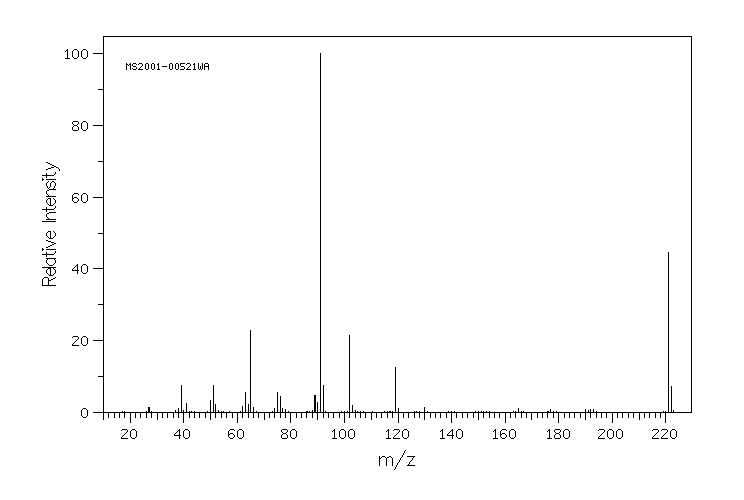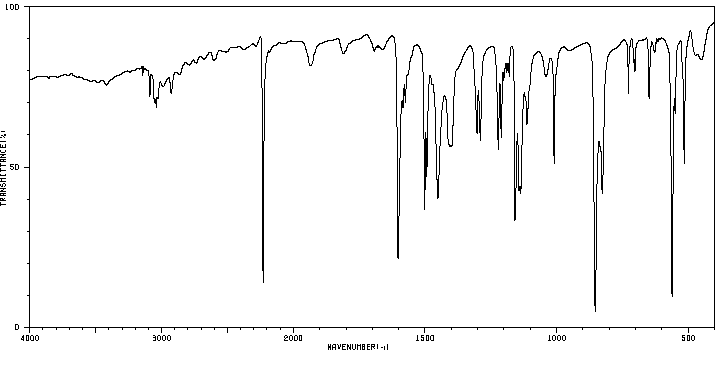4-methyl-4'-cyanoazobenzene | 35653-92-0
中文名称
——
中文别名
——
英文名称
4-methyl-4'-cyanoazobenzene
英文别名
4-Cyano-4'-methylazobenzol;4-[(4-Methylphenyl)diazenyl]benzonitrile
CAS
35653-92-0
化学式
C14H11N3
mdl
——
分子量
221.261
InChiKey
LOYAAZITKAFKMK-UHFFFAOYSA-N
BEILSTEIN
——
EINECS
——
-
物化性质
-
计算性质
-
ADMET
-
安全信息
-
SDS
-
制备方法与用途
-
上下游信息
-
文献信息
-
表征谱图
-
同类化合物
-
相关功能分类
-
相关结构分类
物化性质
-
沸点:394.0±25.0 °C(Predicted)
-
密度:1.07±0.1 g/cm3(Predicted)
计算性质
-
辛醇/水分配系数(LogP):3.8
-
重原子数:17
-
可旋转键数:2
-
环数:2.0
-
sp3杂化的碳原子比例:0.07
-
拓扑面积:48.5
-
氢给体数:0
-
氢受体数:3
上下游信息
-
上游原料
中文名称 英文名称 CAS号 化学式 分子量 达比加群酯杂质32 4-cyanonitrosobenzene 31125-07-2 C7H4N2O 132.122
反应信息
-
作为产物:描述:参考文献:名称:Wide Temperature Range Azobenzene Nematic and Smectic LC Materials摘要:We have developed a series of azobenzene liquid crystals (azo LC) compounds, both multicomponent as well as single component, that possess room temperature nematic and smectic phases. Some of these materials have a wide mesophase temperature range which makes them useful for a variety of practical applications. Two main strategies were used for controlling the temperature range of these mesogenic azo LC materials: 1) chemical modification of azobenzene molecules with different terminal pendants; and 2) development of multicomponent compositions. These materials were highly photosensitive exhibiting nonlinear refraction and transmission at nanowatt/microwatt power levels. Physical, electro- and nonlinear-optical parameters of many of these materials have been characterized in detail.DOI:10.1080/15421400600655733
文献信息
-
REACTION OF ARYLIMODIMAGNESIUM WITH AROMATIC BIFUNCTIONAL NITRILES: COMPETITION AND/OR COOPERATION OF FUNCTIONAL GROUPS AFFECTED BY ELECTRON-ACCEPTING ABILITY AND LOCATION作者:Masao Okubo、Masayo Sakata、Yuko Iwatsu、Nobuyuki Tsurusaki、Sawako Nakashima、Yoshihito Iwamoto、Harumi Nonaka、Akira Yamauchi、Koji MatsuoDOI:10.1002/(sici)1099-1395(199704)10:4<242::aid-poc901>3.0.co;2-u日期:1997.4The reactions of aryliminodimagnesium [ArN(MgBr)(2)IDMg] with p'-substituted p-cyanobenzophenornes, 1-cyano-9-fluorenone, o-, m- and p-dicyanobenzenes and o-, m- and p-nitrobenzonitriles were examined, and the relative yields of products were referred to the previous results of electron spin resonance studies. The products of condensation with carbonyl and nitro groups and of addition to cyano groups were formed. From the variations of the yields caused by the molar ratio of the magnesium reagent versus substrates and by the substituents of both reactants, the preferred groups were determined, The groups of p- and m-substrates are consistent with the position of highest density of free electrons in the anion radicals, whereas those of the o-substrates are inconsistent. The consistency indicate competition of functional groups reflecting the relative ability of single electron acceptance from the reagent, whereas the inconsistency is ascribed to cooperation of neighbouring groups for sigma-complexation with the Mg atom of the reagent, The categories of competition and cooperation are discussed in relation to fundamental features and general governing factors proposed for the IDMg reactions of monofunctional substrates. (C) 1997 by John Wiley & Sons, Ltd.
表征谱图
-
氢谱1HNMR
-
质谱MS
-
碳谱13CNMR
-
红外IR
-
拉曼Raman
-
峰位数据
-
峰位匹配
-
表征信息
同类化合物
黑洞猝灭剂-2,BHQ-2ACID
麦角甾烷-6-酮,2,3,22,23-四羟基-,(2a,3a,5a,22S,23S,24S)-
颜料橙61
阿利新黄GXS
阳离子红X-GTL
阳离子红5BL
阳离子橙RN
阳离子橙GLH
间甲基红
镨(3+)丙烯酰酸酯
镍酸酯(1-),[3-羟基-4-[(4-甲基-3-硫代苯基)偶氮]-2-萘羧酸根(3-)]-,氢
锂3-({4-[(4-羟基苯基)偶氮]-5-甲氧基-2-甲基苯基}偶氮)苯磺酸酯
钴,[二[m-[[1,2-二苯基-1,2-乙二酮1,2-二(肟酸根-kO)](2-)]]四氟二硼酸根(2-)-kN1,kN1',k2,kN2']-,(SP-4-1)-
钠5-氯-2-羟基-3-[(2-羟基-4-{[(4-甲基苯基)磺酰基]氧基}苯基)偶氮]苯磺酸酯
钠5-[[3-[[5-[[4-[[[4-[(4,5-二氢-3-甲基-5-氧代-1H-吡唑-4-基)偶氮]苯基]氨基]羰基]苯基]偶氮]-2,4-二羟基苯基]偶氮]-4-羟基苯基]偶氮]水杨酸盐
钠4-[(4-氨基苯基)偶氮]苯甲酸酯
钠4-[(4-{[4-(二乙基氨基)苯基]偶氮}苯基)偶氮]苯磺酸酯
钠4-[(4-{[2-羟基-5-(2-甲基-2-丙基)苯基]偶氮}苯基)偶氮]苯磺酸酯
钠4-({3-甲氧基-4-[(4-甲氧基苯基)偶氮]苯基}偶氮)苯磺酸酯
钠3-[4-(2-羟基-5-甲基-苯基)偶氮苯基]偶氮苯磺酸酯
钠3-({5-甲氧基-4-[(4-甲氧基苯基)偶氮]-2-甲基苯基}偶氮)苯磺酸酯
钠3-({4-[(4-羟基-2-甲基苯基)偶氮]-3-甲氧基苯基}偶氮)苯磺酸酯
金莲橙O
重氮基烯,苯基[4-(三氟甲基)苯基]-
重氮基烯,二[4-(1-甲基乙基)苯基]-,(Z)-
重氮基烯,二[4-(1-甲基乙基)苯基]-,(E)-
重氮基烯,[4-[(2-乙基己基)氧代]-2,5-二甲基苯基](4-硝基苯基)-
重氮基烯,1,2-二(4-丙氧基苯基)-,(1E)-
重氮基烯,(2-氯苯基)苯基-
酸性金黄G
酸性棕S-BL
酸性媒染棕
酸性媒介棕6
酸性媒介棕48
酸性媒介棕4
酸性媒介棕24
邻氨基偶氮甲苯
达布氨乙基甲硫基磺酸盐
赛甲氧星
茴香酸盐己基
茜素黄 R 钠盐
苯重氮化,2-甲氧基-5-甲基-4-[(4-甲基-2-硝基苯基)偶氮]-,氯化
苯酰胺,4-[4-(2,3-二氢-1,4-苯并二噁英-6-基)-5-(2-吡啶基)-1H-咪唑-2-基]-
苯酚,4-(1,1-二甲基乙基)-2-(苯偶氮基)-
苯酚,2-甲氧基-4-[(4-硝基苯基)偶氮]-
苯胺棕
苯胺,4-[(4-氯-2-硝基苯基)偶氮]-
苯磺酸,3,3-6-(4-吗啉基)-1,3,5-三嗪-2,4-二基二亚氨基2-(乙酰基氨基)-4,1-亚苯基偶氮二-,盐二钠
苯磺酸,2-[(4-氨基-2-羟基苯基)偶氮]-
苯甲酸,5-[[4-[(乙酰基氨基)磺酰]苯基]偶氮]-2-[[3-(三氟甲基)苯基]氨基]-(9CI)








